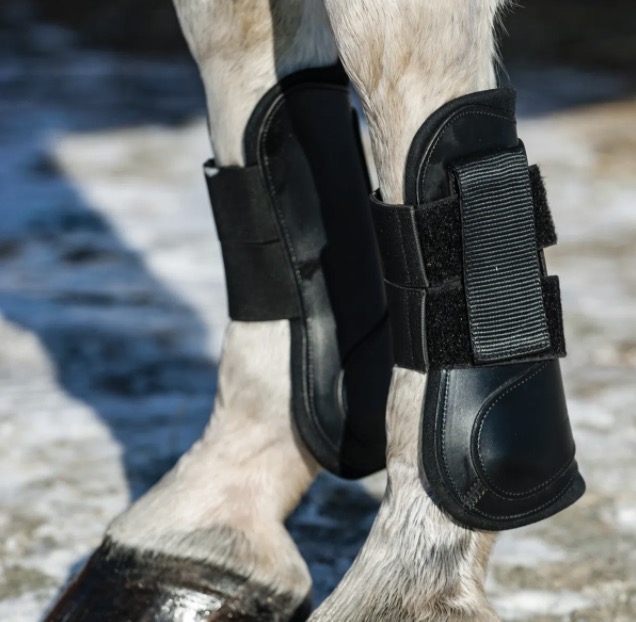You know what’s one awesome thing about riding?
Getting the chance to gallop around fields, arenas and along muddy, woodland trails.
You know what’s not awesome about riding?
Cleaning your brushing boots after galloping around fields, arenas and along muddy, woodland trails. This part is particularly not-awesome if you’re a Type A rider who can’t stand to leave your tack dusty, dirty or in any condition other than sparkling clean.
But with a little bit of prep, products, and elbow grease, cleaning your horse’s brush boots can be a total breeze.
For this tutorial, you’ll need: Your horse’s boots (duh), a stiff dandy brush (Kincade has one that’s only $3.83), a bucket of water, a hose, and a spot to hang your boots to air dry.
Let the material-appropriate washing begin!
Mesh boots

Probably the easiest boots to clean are mesh boots. Mesh means both better airflow for hot legs, and less material for water, dirt, mud and hair to cling to. These boots can hosed off and hung dry, with very little fuss.
Pro tip: If your boots are really dirty, pre-soak in a bucket filled with water and mild soap.
Neoprene boots

Back on Track Front Exercise Boots ($69.00)
Neoprene (the same material that wetsuits are made of) conforms well to legs, providing a secure and comfortable fit for your horse. Just like wetsuits however, it can trap moisture and need to be allowed to dry thoroughly between uses.
Neoprene boots are best hand washed with warm water (better for preserving the material) or a very mild soap and scrubbed gently with a dandy brush.
Pro tip: If your neoprene boots begin to smell, try the trusted tools of scuba divers everywhere and wash them using a neoprene cleaner or odor remover.
PVC Boots

Weatherbeeta Single Lock Brushing Boots ($49.99)
Boots that combine neoprene along with other materials (such as nylon binding or PVC parts) can go in the washer for the occasional deep clean, but opt for cold water and the gentle cycle and don’t use soap. Washing machines are tougher on stitching and materials than hand washing or soaking.
If the boots feature a layer of neoprene on top of another type of liner (like these Nunn Finer boots with a nylon jersey liner), stick with hosing them off and hanging dry as recommended by the manufacturer.
Pro tip: Polish PVC and hard shell boots with Pledge for a showring shine.
Wool or fleece-lined boots

Wool or fleece lined boots can be machine washed with cold water and hung dry as well. (Some wool-lined boots can even be put in the dryer, but check the manufacturer recommendations first!)
Pro tip: Be sure to brush off as much excess dirt as possible first to spare your washing machine.
Leather boots

Leather boots require extra care to prevent cracking (like your saddle or riding boots). To properly clean and condition the leather, saddle soap and leather conditioner are best (or try a combination product like the tried-and-true Fiebing’s Saddle Soap). For those days when you’re in a hurry, leather wipes will do the trick!
For the inner liner and velcro straps, hose with water and scrub with a brush before the sweat dries, then towel dry and hang in a safe spot with good airflow, preferably out of direct sunlight, which can be tough on leather and degrade and fade material over time).
Last but not least, always let the boots dry completely before storage. Trapped moisture and wet boots are breeding grounds for bacteria, which can not only discolor boots and make them smell, but also lead to skin problems when exposed to your horse’s legs.
And there you have it! By taking a few minutes to gather your materials, prep the boots with a dandy brush, and clean them in a manner appropriate for the material, you can have clean and dry boots—all ready to get dirty again on your next horsey adventure.




 June 25, 2020
June 25, 2020 






















